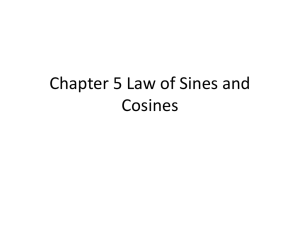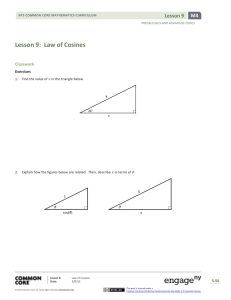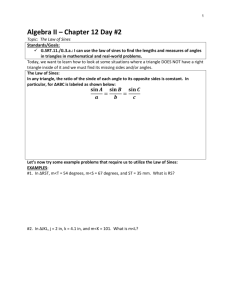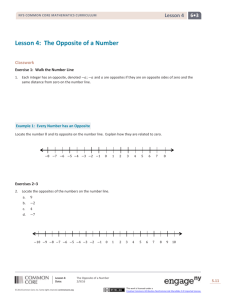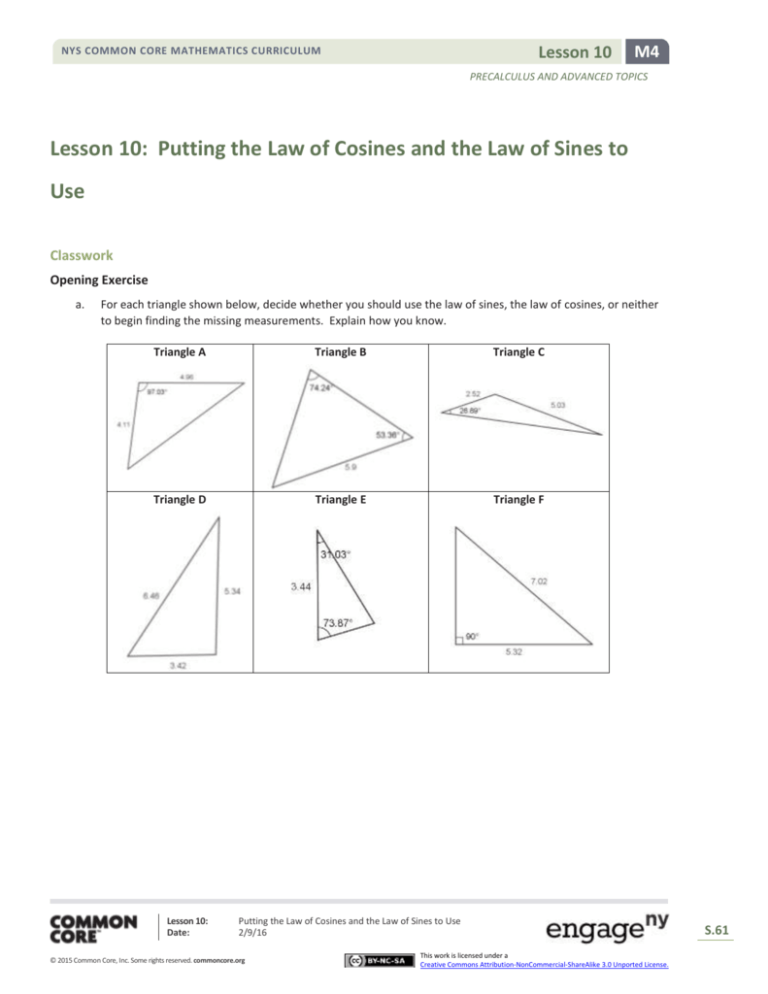
Lesson 10
NYS COMMON CORE MATHEMATICS CURRICULUM
M4
PRECALCULUS AND ADVANCED TOPICS
Lesson 10: Putting the Law of Cosines and the Law of Sines to
Use
Classwork
Opening Exercise
a.
For each triangle shown below, decide whether you should use the law of sines, the law of cosines, or neither
to begin finding the missing measurements. Explain how you know.
Triangle A
Triangle B
Triangle C
Triangle D
Triangle E
Triangle F
Lesson 10:
Date:
Putting the Law of Cosines and the Law of Sines to Use
2/9/16
© 2015 Common Core, Inc. Some rights reserved. commoncore.org
This work is licensed under a
Creative Commons Attribution-NonCommercial-ShareAlike 3.0 Unported License.
S.61
Lesson 10
NYS COMMON CORE MATHEMATICS CURRICULUM
M4
PRECALCULUS AND ADVANCED TOPICS
b.
What types of given information will help you to decide which formula to use to determine missing
measurements? Summarize your ideas in the table shown below:
Determining Missing Measurements
Given Measurements
Right Triangle
Formulas to Use
Trigonometry Functions
Pythagorean Theorem
Non-Right Triangle
Law of Sines
Non-Right Triangle
Law of Cosines
Lesson 10:
Date:
Putting the Law of Cosines and the Law of Sines to Use
2/9/16
© 2015 Common Core, Inc. Some rights reserved. commoncore.org
This work is licensed under a
Creative Commons Attribution-NonCommercial-ShareAlike 3.0 Unported License.
S.62
Lesson 10
NYS COMMON CORE MATHEMATICS CURRICULUM
M4
PRECALCULUS AND ADVANCED TOPICS
Exercises 1–7
1.
A landscape architect is given a survey of a parcel of land that is shaped like a parallelogram. On the scale drawing
the sides of the parcel of land are 8 in. and 10 in., and the angle between these sides measures 75°. The architect is
planning to build a fence along the longest diagonal. If the scale on the survey is 1 in. = 120 ft., how long will the
fence be?
2.
A regular pentagon is inscribed in a circle with a radius of 5 cm. What is the perimeter of the pentagon?
3.
At the base of a pyramid, a surveyor determines that the angle of elevation to the top is 53°. At a point 75 meters
from the base, the angle of elevation to the top is 35°. What is the distance from the base of the pyramid up the
slanted face to the top?
Lesson 10:
Date:
Putting the Law of Cosines and the Law of Sines to Use
2/9/16
© 2015 Common Core, Inc. Some rights reserved. commoncore.org
This work is licensed under a
Creative Commons Attribution-NonCommercial-ShareAlike 3.0 Unported License.
S.63
Lesson 10
NYS COMMON CORE MATHEMATICS CURRICULUM
M4
PRECALCULUS AND ADVANCED TOPICS
4.
A surveyor needs to determine the distance across a lake between an existing ferry dock at point 𝐴 and a second
dock across the lake at point 𝐵. He locates a point 𝐶 along the shore from the dock at point 𝐴 that is 750 meters
away. He measures the angle at 𝐴 between the sight lines to points 𝐵 and 𝐶 to be 65° and the angle at 𝐶 between
the sight lines to points 𝐴 and 𝐵 to be 82°. How far is it from the dock at 𝐴 and the dock at 𝐵?
5.
Two people located 500 yards apart have spotted a hot air balloon. The angle of elevation from one person to the
balloon is 67°. From the second person to the balloon the angle of elevation is 46°. How high is the balloon when it
is spotted?
When applying mathematics to navigation, direction is often given as a bearing. The bearing of an object is the degrees
rotated clockwise from north that indicates the direction of travel or motion. The next exercises apply the law of cosines
and the law of sines to navigation problems.
6.
Two fishing boats start from a port. One travels 15 nautical miles per hour on a bearing of 25° and the other
travels 18 nautical miles per hour on a bearing of 100°. Assuming each maintains its course and speed, how far
apart will the fishing boats be after two hours?
Lesson 10:
Date:
Putting the Law of Cosines and the Law of Sines to Use
2/9/16
© 2015 Common Core, Inc. Some rights reserved. commoncore.org
This work is licensed under a
Creative Commons Attribution-NonCommercial-ShareAlike 3.0 Unported License.
S.64
Lesson 10
NYS COMMON CORE MATHEMATICS CURRICULUM
M4
PRECALCULUS AND ADVANCED TOPICS
7.
An airplane travels on a bearing of 200° for 1500 miles and then changes to a bearing of 250° and travels an
additional 500 miles. How far is the airplane from its starting point?
Example: Revisiting Vectors and Resultant Forces
The goalie on the soccer team kicks a ball with an initial force of 135 Newtons at a 40° angle with the ground. The mass
m
of a soccer ball is 0.45 kg. Assume the acceleration due to gravity is 9.8 2 .
s
a.
Draw a picture representing the force vectors acting on the ball and the resultant force vector.
Lesson 10:
Date:
Putting the Law of Cosines and the Law of Sines to Use
2/9/16
© 2015 Common Core, Inc. Some rights reserved. commoncore.org
This work is licensed under a
Creative Commons Attribution-NonCommercial-ShareAlike 3.0 Unported License.
S.65
Lesson 10
NYS COMMON CORE MATHEMATICS CURRICULUM
M4
PRECALCULUS AND ADVANCED TOPICS
b.
What is magnitude of the resultant force vector?
c.
What are the horizontal and vertical components of this vector?
d.
What is the angle of elevation of the resulting vector?
Lesson 10:
Date:
Putting the Law of Cosines and the Law of Sines to Use
2/9/16
© 2015 Common Core, Inc. Some rights reserved. commoncore.org
This work is licensed under a
Creative Commons Attribution-NonCommercial-ShareAlike 3.0 Unported License.
S.66
Lesson 10
NYS COMMON CORE MATHEMATICS CURRICULUM
M4
PRECALCULUS AND ADVANCED TOPICS
Exercises 8–10
8.
Suppose a soccer player runs up to a moving soccer ball located at 𝐴 and kicks the ball into the air. The diagram
below shows the initial velocity of the ball along the ground and the initial velocity and direction of the kick. What is
the resultant velocity and angle of elevation of the soccer ball immediately after it is kicked?
Lesson 10:
Date:
Putting the Law of Cosines and the Law of Sines to Use
2/9/16
© 2015 Common Core, Inc. Some rights reserved. commoncore.org
This work is licensed under a
Creative Commons Attribution-NonCommercial-ShareAlike 3.0 Unported License.
S.67
Lesson 10
NYS COMMON CORE MATHEMATICS CURRICULUM
M4
PRECALCULUS AND ADVANCED TOPICS
9.
A 13 lb. force and a 20 lb. force are applied to an object located at 𝐴 as shown in the diagram below. What is the
resulting force and direction being applied to the object at 𝐴?
Lesson 10:
Date:
Putting the Law of Cosines and the Law of Sines to Use
2/9/16
© 2015 Common Core, Inc. Some rights reserved. commoncore.org
This work is licensed under a
Creative Commons Attribution-NonCommercial-ShareAlike 3.0 Unported License.
S.68
Lesson 10
NYS COMMON CORE MATHEMATICS CURRICULUM
M4
PRECALCULUS AND ADVANCED TOPICS
10. A motorboat is travels across a lake at a speed of 10 mph at a bearing of 25°. The current of the lake due to the
wind is a steady 2 mph at a bearing of 340°.
a.
Draw a diagram that shows the two velocities that are affecting the boat’s motion across the lake.
b.
What is the resulting speed and direction of the boat?
Lesson 10:
Date:
Putting the Law of Cosines and the Law of Sines to Use
2/9/16
© 2015 Common Core, Inc. Some rights reserved. commoncore.org
This work is licensed under a
Creative Commons Attribution-NonCommercial-ShareAlike 3.0 Unported License.
S.69
Lesson 10
NYS COMMON CORE MATHEMATICS CURRICULUM
M4
PRECALCULUS AND ADVANCED TOPICS
Lesson Summary
The law of sines and the law of cosines can be used to solve problems that can be represented with triangles with
three known measurements.
The law of sines and the law of cosines can be used to find the magnitude and direction of the resultant sum of two
vectors, which can represent velocities, distances, or forces.
Problem Set
1.
For each of the situations below, determine whether to use Pythagorean theorem, right-triangle trigonometry, law
of sines, law of cosines, or some other method.
a.
b.
Know one side and an angle of a right triangle, and want to find any other side.
c.
d.
Know two angles of a triangle and want to find the third.
Lesson 10:
Date:
Putting the Law of Cosines and the Law of Sines to Use
2/9/16
© 2015 Common Core, Inc. Some rights reserved. commoncore.org
This work is licensed under a
Creative Commons Attribution-NonCommercial-ShareAlike 3.0 Unported License.
S.70
Lesson 10
NYS COMMON CORE MATHEMATICS CURRICULUM
M4
PRECALCULUS AND ADVANCED TOPICS
e.
f.
Know three sides of a triangle and want to find an angle.
g.
h.
Know a side and two angles and want to find the third angle.
i.
Lesson 10:
Date:
Putting the Law of Cosines and the Law of Sines to Use
2/9/16
© 2015 Common Core, Inc. Some rights reserved. commoncore.org
This work is licensed under a
Creative Commons Attribution-NonCommercial-ShareAlike 3.0 Unported License.
S.71
Lesson 10
NYS COMMON CORE MATHEMATICS CURRICULUM
M4
PRECALCULUS AND ADVANCED TOPICS
2.
Mrs. Lane’s trigonometry class has been asked to judge the annual unmanned hot-air balloon contest, which has a
prize for highest flying balloon.
a.
Sarah thinks that the class needs to set up two stations to sight each balloon as it passes between them.
Construct a formula that Mrs. Lane’s class can use to find the height of the balloon by plugging the two angles
of elevation so that they can program their calculators to automatically output the height of the balloon. Use
500 ft. for the distance between the stations and 𝛼 and 𝛽 for the angles of elevation.
b.
The students expect the balloons to travel no higher than ft. What distance between the stations would you
recommend? Explain.
c.
Find the heights of balloons sighted with the following angles of elevation to the nearest ten feet. Assume a
distance of 500 ft. between stations.
i.
5°, 15°
ii.
38°, 72°
iii.
45°, 45°
iv.
45°, 59°
v.
28°, 44°
vi.
50°, 66°
vii. 17°, 40°
3.
d.
Based on your results in part (c), which balloon won the contest?
e.
The balloons were released several hundred feet away, but directly in the middle of the two stations. If the
first angle represents the West station and the second angle represents the East station, what can you say
about the weather conditions during the contest?
f.
Are there any improvements to Mrs. Lane’s class’s methods that you would suggest? Explain.
Bearings on ships are often given as a clockwise angle from the direction the ship is heading (0° represents
something in the path of the boat and 180° represents something behind the boat). Two ships leave port at the
1
2
same time. The first ship travels at a constant speed of 30 kn. After 2 hours, the ship sights the second at a
bearing of 110° and 58 nautical miles away.
4.
5.
a.
How far is the second ship from the port where it started?
b.
How fast is the second ship traveling on average?
A paintball is fired from a gun with a force of 59 N at an angle of elevation of 1°. If the force due to gravity on the
paintball is 0.0294 N, then answer the following:
a.
Is this angle of elevation enough to overcome the initial force due to gravity and still have an angle of elevation
greater than 0.5°?
b.
What is the resultant magnitude of the vector in the direction of the paintball?
Valerie lives 2 miles west of her school and her friend Yuri lives 3 miles directly northeast of her.
a.
Draw a diagram representing this situation.
b.
How far does Yuri live from school?
c.
What is the bearing of the school to Yuri’s house?
Lesson 10:
Date:
Putting the Law of Cosines and the Law of Sines to Use
2/9/16
© 2015 Common Core, Inc. Some rights reserved. commoncore.org
This work is licensed under a
Creative Commons Attribution-NonCommercial-ShareAlike 3.0 Unported License.
S.72
Lesson 10
NYS COMMON CORE MATHEMATICS CURRICULUM
M4
PRECALCULUS AND ADVANCED TOPICS
6.
A 2.1-kg rocket is launched at an angle of 33° with an initial force of 50 N. Assume the acceleration due to gravity is
m
9.81 2 .
s
a.
Draw a picture representing the force vectors and their resultant vector.
b.
What is the magnitude of the resultant vector?
c.
What are the horizontal and vertical components of the resultant vector?
d.
What is the angle of elevation of the resultant vector?
7.
Use the distance formula to find 𝑐, the distance between 𝐴 and 𝐵 for ∆𝐴𝐵𝐶, with 𝐴 = (𝑏 cos(𝛾) , 𝑏 sin(𝛾)), 𝐵 =
(𝑎, 0), and 𝐶 = (0,0). After simplifying, what formula have you proven?
8.
For isosceles triangles with 𝑎 = 𝑏, show the law of cosines can be written as cos(𝛾) = 1 −
Lesson 10:
Date:
𝑐2
.
2𝑎2
Putting the Law of Cosines and the Law of Sines to Use
2/9/16
© 2015 Common Core, Inc. Some rights reserved. commoncore.org
This work is licensed under a
Creative Commons Attribution-NonCommercial-ShareAlike 3.0 Unported License.
S.73

